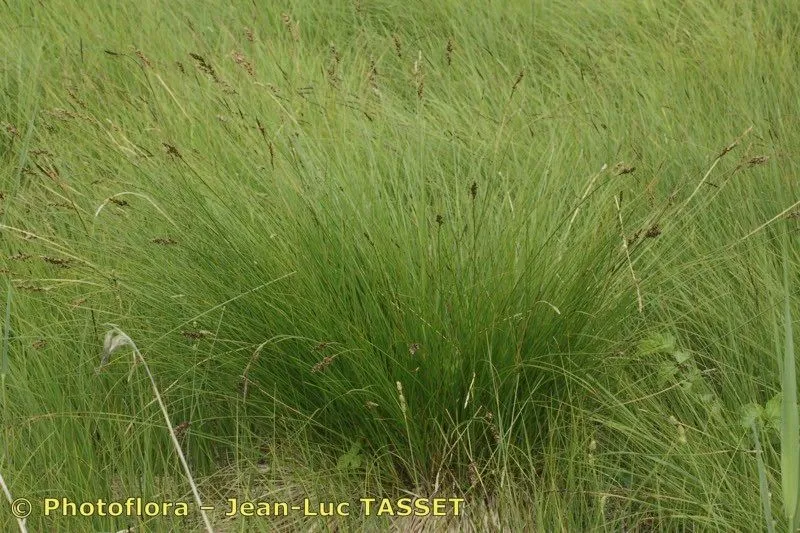
Author: Schumach.
Bibliography: Enum. Pl. 1: 266 (1801)
Year: 1801
Status: accepted
Rank: species
Genus: Carex
Vegetable: False
Observations: Europe to Caucasus
Fibrous tussock sedge, scientifically identified as Carex appropinquata, is a notable species within the Cyperaceae family. This plant is distinguished by its characteristic growth pattern, forming dense, fibrous tussocks which give it its common name. The tussocks provide a unique texture within its natural habitat, contributing to the plant’s ecological role in those environments.
Native to a vast region stretching from Europe to the Caucasus, Carex appropinquata thrives in a variety of wetland habitats. This includes bogs, fens, and damp, meadow-like environments where the soil moisture is consistently high. Its robust nature allows it to survive in these wet conditions, playing a crucial role in stabilizing soil and providing habitat for a multitude of wildlife species.
The plant typically features narrow, grass-like leaves that extend upwards, often reaching substantial lengths which enhance its distinctive tussock formation. It is an important member of its ecosystems, contributing to soil integrity and offering shelter and food resources for various insects and other small animals.
First described by Schumach. in 1801, this sedge has been a subject of botanical interest for over two centuries. The primary reference for its description can be found in the botanical enumeration, “Enum. Pl. 1: 266 (1801),” providing early documentation of its characteristics and native range.
In summary, Carex appropinquata, or fibrous tussock sedge, is an ecologically significant species within the Cyperaceae family. Its presence from Europe to the Caucasus underscores its adaptability and importance in wetland ecosystems, making it a valuable plant for both scientific study and environmental conservation.
Dan: langakset star
Deu: schwarzschopf-segge, wundersegge
Eng: fibrous tussock-sedge
Fra: laîche paradoxale
Nld: paardenhaarzegge
Fin: röyhysara
Swe: röyhysara, tagelstarr, oxstarr
Nob: taglstarr
Nno: taglstorr
Sme: bolfelukti
Cym: hesg ffibrog, hesgen fanedafedd, hesgen ffibrog
En: Fibrous Tussock Sedge, Fibrous Tussock-sedge
Be: Асака збліжаная
Cs: Ostřice odchylná
Da: Langakset star
Nl: Paardenhaarzegge, Paardehaarzegge
Et: Eristarn
Fi: Röyhysara
Fr: Laîche paradoxale, Laiche à épis rapprochés, Laîche à épis rapprochés, Laiche paradoxale
De: Gedrängtährige Segge, Schwarzkopf-Segge, Schwarzkopfsegge, Sonderbare Segge, Wunder-Segge, Wundersegge, Schwarzschopf-Segge
Hu: Rostostövű sás
It: Carice ravvicinata
Lv: Satuvinātais grīslis
Lt: Šeriuotoji viksva
Se: Bolfelukti
Nb: Taglstarr
Nn: Taglstorr
Fa: کارکس اپروپینکواتا
Pl: Turzyca tunikowa
Ru: Осока сближенная
Sv: Tagelstarr, Röyhysara, Oxstarr
Cy: Hesgen ffibrog, Hesg Ffibrog, Hesgen Fanedafedd
: Fibrous tussock sedge
Taken Jul 15, 2014 by Photoflora – Jean-Luc TASSET (©)
Taken Jul 15, 2014 by Photoflora – Jean-Luc TASSET (©)
Taken Jul 15, 2014 by Photoflora – Jean-Luc TASSET (©)
Taken Aug 15, 2004 by Photoflora – Jean-Luc TASSET (©)
Taken Aug 15, 2000 by Photoflora – Jean-Luc TASSET (©)
Taken Aug 17, 2020 by kafaktor (cc-by-sa)
Taken Jul 15, 2014 by Photoflora – Jean-Luc TASSET (©)
Taken Aug 15, 2004 by Photoflora – Jean-Luc TASSET (©)
Taken Aug 17, 2020 by kafaktor (cc-by-sa)
Taken Aug 15, 2004 by Photoflora – Jean-Luc TASSET (©)
Taken May 6, 2022 by Rabenau Philip (cc-by-sa)
Taken Jul 15, 2014 by Photoflora – Jean-Luc TASSET (©)
Taken Jul 15, 2006 by Photoflora – Yann QUELEN (©)
Taken Jul 15, 2006 by Photoflora – Yann QUELEN (©)
Taken Aug 15, 2004 by Photoflora – Jean-Luc TASSET (©)
Taken Jul 15, 2014 by Photoflora – Jean-Luc TASSET (©)
Taken Jan 1, 1970 by Photoflora – L’Abbé COSTE (©)
Ph maximum: 8.0
Ph minimum: 7.5
Light: 8
Atmospheric humidity: 9
Bloom months: [‘apr’, ‘may’, ‘jun’, ‘jul’]
Soil nutriments: 4
Family: Myrtaceae Author: (F.Muell.) K.D.Hill & L.A.S.Johnson Bibliography: Telopea 6: 402 (1995) Year: 1995 Status:…
Family: Rubiaceae Author: Pierre ex A.Froehner Bibliography: Notizbl. Bot. Gart. Berlin-Dahlem 1: 237 (1897) Year:…
Family: Sapindaceae Author: Koidz. Bibliography: J. Coll. Sci. Imp. Univ. Tokyo 32(1): 38 (1911) Year:…
Family: Asteraceae Author: A.Gray Bibliography: Pacif. Railr. Rep.: 107 (1857) Year: 1857 Status: accepted Rank:…
Family: Fabaceae Author: Medik. Bibliography: Vorles. Churpfälz. Phys.-Ökon. Ges. 2: 398 (1787) Year: 1787 Status:…
Family: Aspleniaceae Author: (Cav.) Alston Bibliography: Bull. Misc. Inform. Kew 1932: 309 (1932) Year: 1932…